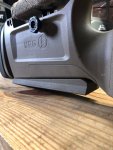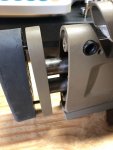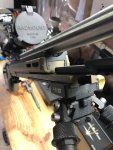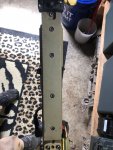Brass is heavier than steel, but not by much. Tungsten.. just add a zero to the end of the price and you might get close. Also Tungsten stucks to machine.
Join the Hide community
Get access to live stream, lessons, the post exchange, and chat with other snipers.
Register
Download Gravity Ballistics
Get help to accurately calculate and scope your sniper rifle using real shooting data.

Install the app
How to install the app on iOS
Follow along with the video below to see how to install our site as a web app on your home screen.
Note: This feature may not be available in some browsers.
You are using an out of date browser. It may not display this or other websites correctly.
You should upgrade or use an alternative browser.
You should upgrade or use an alternative browser.
Steel ARCA rails
- Thread starter Bear9350
- Start date
Any update on if the steel rails are a go?
I've got an order in with the guys at the shop. I'm hoping by next weekend I will have them back and get it fitted up on my rifle to see how it is going to work out.
I'm thinking the one thing of stopping steel arc rails is likely something related to the ease/accuracy of milling aluminum vs steel and that most if not all arca clamps are aluminum. Aluminum clamping/sliding on steel would not wear well................... now that is just me thinking out loud. I bet if you contacted somebody like Area 419 or KRG, directly those guys would give you a solid answer. my personal experience is they are willing to answer questions.
I deal a lot with welding and stamping and have a lot of experience in those areas. I don't have a whole lot of experience with machining parts. I'm sure there are plenty of guys on here that could speak much more intelligently on the subject. I think both material have pros and cons when it comes to machineabilty.
If the aluminum parts are hard anodized like some of them are, they will be very hard. Harder then the 1018 steel I am planning on milling these parts from. Regular aluminum would definitely be softer.
Unless your aluminum clamps are raw, you’re not going to need to worry about them reacting with a steel rail.
I still haven’t had my question answered about how people buying aluminum rails are paying more. More than what? Does someone a) have a steel rail on the market? and b) how is it somehow cheaper than an aluminum one?
I still haven’t had my question answered about how people buying aluminum rails are paying more. More than what? Does someone a) have a steel rail on the market? and b) how is it somehow cheaper than an aluminum one?
Marketing? Haha my guess is most aluminum rails also have a lot of lightening cuts and added machine work to keep weight down then hard coated. This steel rail is just a bar with angled cuts so not very much machine work.Unless your aluminum clamps are raw, you’re not going to need to worry about them reacting with a steel rail.
I still haven’t had my question answered about how people buying aluminum rails are paying more. More than what? Does someone a) have a steel rail on the market? and b) how is it somehow cheaper than an aluminum one?
So I already posted above how the weight of a 14" steel rail is comparable in weight to the 419 rail with all the brass weights added.Unless your aluminum clamps are raw, you’re not going to need to worry about them reacting with a steel rail.
I still haven’t had my question answered about how people buying aluminum rails are paying more. More than what? Does someone a) have a steel rail on the market? and b) how is it somehow cheaper than an aluminum one?
The aluminum stock itself is going to be more expensive. Then you add extra processing steps to mill the pockets to place the weights. Then you need to make the brass weights. This is additional material that needs to be purchased and then processed. Then you need to add the cost of whatever fasteners will be used to attach the weights to the rail.
Not caring about weight, a standard steel rail would likely cost similar to aluminum. Material cost and processing would all be similar. I guess I was specifically referencing the cost of adding weight to the aluminum rail.
You think the aluminum is going to be more expensive?So I already posted above how the weight of a 14" steel rail is comparable in weight to the 419 rail with all the brass weights added.
The aluminum stock itself is going to be more expensive. Then you add extra processing steps to mill the pockets to place the weights. Then you need to make the brass weights. This is additional material that needs to be purchased and then processed. Then you need to add the cost of whatever fasteners will be used to attach the weights to the rail.
Not caring about weight, a standard steel rail would likely cost similar to aluminum. Material cost and processing would all be similar. I guess I was specifically referencing the cost of adding weight to the aluminum rail.
Regardless, the machining time of the steel rail is going to be longer. I'm not seeing your projected cost savings, especially with nothing to ralate them to.
Probably be cheaper to make one of out $100 bills.How about a tungsten rail? Just thinking out of the box here.
Area 419 has just what you are looking for. I’m getting two:
Problem with that is it’s only in 14” version, which for a bravo or other krg chassis types is way to long (4”) off the front end.Area 419 has just what you are looking for. I’m getting two:
My J Allen Arca-6 is...
...ready for it?...
...6” off the front.
...ready for it?...
...6” off the front.
Let it all hang out huh? LolMy J Allen Arca-6 is...
...ready for it?...
...6” off the front.
This is the stuff I made. All out of a .5" x 1.5" piece of 1018.Any pics of a finished one installed? This is pretty dope stuff
I added some .75 x 3" solid bar stock to the butt pad spacer to balance the thing out when I run a suppressor.
The bag rider I modeled up and had printed by a customer out of glass filled nylon (PA 3200 GF). It attaches using the existing fastener locations, just with longer bolts.
None of this stuff has helped me be a better shooter....but it does make the rifle heavier.




Haha, welp, it was worth a try anyway.None of this stuff has helped me be a better shooter....but it does make the rifle heavier.
What did the Arca rail weight end up being finished?
2.5 lbsHaha, welp, it was worth a try anyway.
What did the Arca rail weight end up being finished?
talked to bear9350 yesterday, said he just got them back from the shop and was gonna Mount one and make sure they worked with arca clampsAny updates on these?
talked to bear9350 yesterday, said he just got them back from the shop and was gonna Mount one and make sure they worked with arca clamps
Same.
@Bear9350 any new info?
Sorry for the delay fellas. Got the milled rails back last week but had been busy and didn’t have time to get it installed right away.
The rail as I received them.


I have a 419 clamp with the pins removed. It fit well and clamped down well.

At first my plan was to cut it down to 9-3/4” inches to fit just the length of the forend. After some fit-up I decided to leave it the full 12”.
I located and drilled the holes in the appropriate places.

My plan was to insert a steel bar into the chassis to bolt the rail to. I had a couple pieces laser cut to slip inside the chassis. The notches needed to be cut out for clearance where the bolts pass through to attach the forend grip to the chassis. I drilled and tapped holes to mount the rail to. I tapped for an M5 to match the rest of the hardware on my Bravo chassis.



Then bolted everything back together.


Did a little dry fire practice and made it to the range once so far. Everything is functioning well. I am thinking I will add a thumb rest to the front of the internal mounting bracket I made. When shooting off of a barricade with a bag I like to clamp the rifle to my bag with my left hand. The gap between the barrel and steel insert worked pretty well for me to clamp my thumb on but I would like to make just a bit larger of a shelf there.

I also had a few butt spacers laser cut to balance things back out. With everything installed and an M24 contour barrel I am just a bit over 20 pounds. I don’t have a great scale to get a precise measurement.

The rail as I received them.


I have a 419 clamp with the pins removed. It fit well and clamped down well.

At first my plan was to cut it down to 9-3/4” inches to fit just the length of the forend. After some fit-up I decided to leave it the full 12”.
I located and drilled the holes in the appropriate places.

My plan was to insert a steel bar into the chassis to bolt the rail to. I had a couple pieces laser cut to slip inside the chassis. The notches needed to be cut out for clearance where the bolts pass through to attach the forend grip to the chassis. I drilled and tapped holes to mount the rail to. I tapped for an M5 to match the rest of the hardware on my Bravo chassis.



Then bolted everything back together.


Did a little dry fire practice and made it to the range once so far. Everything is functioning well. I am thinking I will add a thumb rest to the front of the internal mounting bracket I made. When shooting off of a barricade with a bag I like to clamp the rifle to my bag with my left hand. The gap between the barrel and steel insert worked pretty well for me to clamp my thumb on but I would like to make just a bit larger of a shelf there.

I also had a few butt spacers laser cut to balance things back out. With everything installed and an M24 contour barrel I am just a bit over 20 pounds. I don’t have a great scale to get a precise measurement.

Waiting for the muzzle brake-hitch attachment and bi-pod with wheels to you can cart the lead sled around the range


I sent him an email yesterday and he said materials should be in yesterday and he would be shipping today.
Sorry for the delay guys. The first set of steel inserts I got back didn't line up quite right and I needed to get them re-cut. If you were waiting on a rail it shipped today and should arrive Monday per tracking unless I sent you a message indicating other wise.
Got mine mounted up! Left it at 12” so 2” stick out in front. Works perfectly with the btc-pro and looks good too.
Anybody ever come up with an steel arca option? Looking for one on a TCS
Have you looked at the KRG version? It has enough mounting options that I'll be you could make it work on a LOT of things....Anybody ever come up with an steel arca option? Looking for one on a TCS
Arca Rail, Heavy (KRG) – Kinetic Research Group
 kineticresearchgroup.com
kineticresearchgroup.com
interesting. I'll give it a lookHave you looked at the KRG version? It has enough mounting options that I'll be you could make it work on a LOT of things....
Arca Rail, Heavy (KRG) – Kinetic Research Group
kineticresearchgroup.com
One thing to note is that for some reason, aluminum and steel have some serious holding friction when clamped together. I’m no engineer, but it seems like that combo has way more friction “lock” than aluminum on aluminum. Not sure about steel on steel…sorta doubt it.
Must be perceived, because Al to Al has much higher friction coeff than Al to steel.
Your post is correct as far as it goes, but the truth is that in this application, neither the aluminum nor the steel is typically uncoated. That’s one reason why aluminum fittings are always coated, to reduce the coefficient of friction and therefore galling.Must be perceived, because Al to Al has much higher friction coeff than Al to steel.
View attachment 7615312
This does not mean that I am argueing your point or trying to disagree, just pointing it out.
Last edited:
Your post is correct as far as it goes, but the truth is that in this application, neither the aluminum nor the steel is typically uncoated. That’s one reason why aluminum fittings are always coated, to reduced the coefficient of friction and therefore galling.
This does not mean that I am argueing your point not trying to disagree, just pointing it out.
I know they would typically be coated, but he didn't mention anything about coating.
There is a steel area419 one made specifically for the tcs. You might have to get it directly through manners though. It was an option when purchasing my tcs directly through themAnybody ever come up with an steel arca option? Looking for one on a TCS
Similar threads
- Replies
- 58
- Views
- 2K
- Replies
- 4
- Views
- 572
- Replies
- 11
- Views
- 2K

